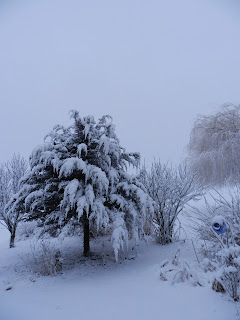.JPG) |
| Still green hips |
Rose hips look beautiful on the plant and in photographs. They will be bright and lovely after a snow storm.
Rose hips have been used for Vitamin C rich tea, as a sweetener and flavouring, to make preserves, vinegars and wine. It's good as a flavouring for ice-cream and added to cough mixtures. (*2) Herbalist use rose hip seed oil as a skin treatment, boosting tissue regeneration and rejuvenation. It is claimed to have 8 times the vitamin C, weight for weight, as oranges.
 |
| Orange hips |
And to get totally off track, sort of, my maiden name "Shenk" was originally "Schenck" in the old country of Switzerland. A rather large pharmaceutical firm in the 1800s was the Schenck Chemical Co., New York City. Most famous for their Schenck's Mandrake Pills and compound, they are now termed hucksters. I've collected some of their advertising and pill containers and it was guaranteed to cure most any disease known to man.
I mention this to caution the reader, gardener, and herbalist to research suggested natural cures before ingesting. Some work, some don't and some can be dangerous when used in certain circumstances. Natural does not always mean harmless.
There are several recipes for rose hip foods. They'll have their own specific taste. The taste is most often referred to as delicate and the same as the rose smell.
Rose oil and rose water are made from either crushed/boiled hips, buds, leaves or petals. As in history, it is used in perfumes, cooking, and medicinal treatments.
And some place in my external drive I have some lovely snow covered rose hip photos - somewhere. You know that somewhere you put something so you'd be able to find it - never to be seen again?
(*1) John Gerard's "Herbal - the History of Plants" was written in the late 1800s and the word "hips" was not mentioned. They were only called fruits. Love this book for it's old English poetic rhythm and for a look at how people lived and used plant life.
(*2) "The healing garden - nature's remedies and cures" by Helen Farmer-Knowles.
 |
| I'm just sure there are rose hips somewhere under this snow! |

No comments:
Post a Comment